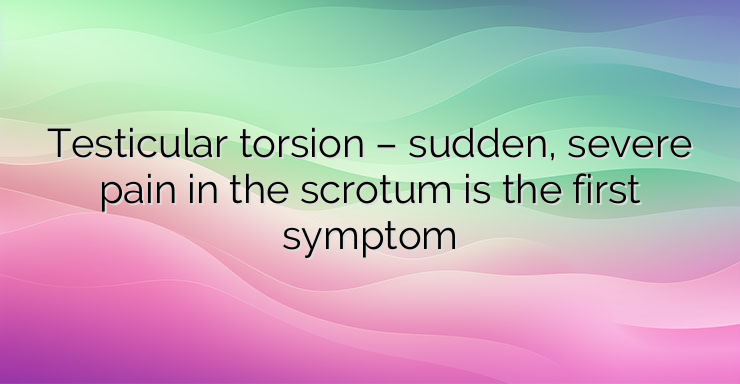The testicles are a paired organ that descends freely into the scrotum or scrotum. The innervation, blood supply and lymphatic drainage of the testis is provided by the structures of the spermatic cord. There are also the vessels that are responsible for the blood supply and nutrition of the testicles, so that their most important function – spermatogenesis – can be performed. Testicular torsion is a twisting of the structures of the spermatic cord in or just below the inguinal canal. This leads to a sudden interruption of blood flow to one or both testicles, which creates complaints and is treated as an emergency in urology. Torsion occurs in 1 in 4,000 men under the age of 25. Although less common, torsion can occur prenatally, in childhood, or in elderly patients. Physiologically, torsion of the testis around the spermatic cord is prevented by the presence of an abundant amount of connective tissue that serves to firmly attach the testis to the scrotum. But in cases where this tissue is poorly represented, which may be present at birth, torsion is much more likely to occur. This is due to the fact that the testicles “swing” freely in the scrotal cavity and can easily twist. Testicular torsion can occur on either side, more commonly the left, but rarely both testicles are affected. Risk factors for the occurrence of torsion are some congenital abnormalities in the development of the testicles or their shell and trauma in the groin area. Certain sports, such as wrestling or football, can also be responsible for its onset at a younger age. And yet there are cases described that occur even at rest or during sleep. Torsion of the spermatic cord disrupts the blood supply to the testis and epididymis. The degree of twist is from 180 to 720 degrees. As testicular congestion increases, torsion deepens. The consequences for the affected testicle and its atrophy are determined by the degree and duration of the torsion. This determines the urgency of diagnosis and timely treatment. The most common symptom that indicates testicular torsion is a sharp, severe and sudden pain on one side of the scrotum. The sudden onset with subsequent unilateral swelling of the testicle, without a rise in body temperature, easily points to the diagnosis. It is placed by a urologist through careful history taking, physical examination and ultrasound examination. Color Doppler will detect an interruption of blood flow to the testicle in question. Separately, ultrasound examination can differentiate traumatic changes as a result of testicular contusion – the most common differential diagnosis with torsion. A contusion, a hematoma in the scrotal cavity, or even a testicular rupture are very well imaged using this technique. In the differential diagnosis plan, the presence of hematocele, varicocele, cysts of the epididymis and inguinal hernia can also be depicted.which are responsible for the occurrence of swelling and pain in the corresponding testicle. Treatment is urgently required because prolonged ischemia of the affected testicle significantly compromises its function. The functional state of the organ can be preserved with medical intervention up to 6-8 hours after the onset of symptoms. After 12-24 hours, the onset of infarction and necrosis of the testicle make its damage irreversible, which may even necessitate its removal. Treatment consists of detorquing (de-torsion or untwisting) the testis in the presence of assessed good vitality and a macroscopically apparently preserved testis. In cases where this intervention is delayed for more than 12 hours, the testis is not vital and no normal tissue is found to be preserved. In this case, it is necessary to carry out an orchidectomy or removal of the testicle in order to avoid the late complications that follow for the whole organism. References: 1. Urology, Prof. P. Panchev; 2. Urologyhealth – urologic conditions, testicular torsion


Leave a Reply